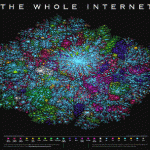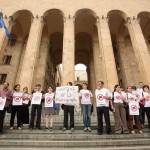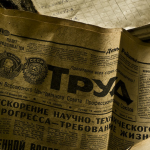Wikipedia blackout
In november last year I wrote a piece on the new law proposal called SOPA (Stop Online Piracy Act). Among other things I criticized the proposal through the following argument:
“The bill seem to be a result of a very strange view of the media technology and people’s use of it. Of course, the proposal comes out of an interplay between political powers and economic interests and can not really be judged by normative ideals. But it is important to point out how a vision of the Internet as a force which cannot be imposed on citizens, but must be controlled from above, emerges and can be read between the lines. The starting point can not be more wrong. On the contrary, we should work towards the integration of technology, society and citizens and not divide the categories and distancing them from each other, which is what the bill might result in. Instead we are to work actively for solutions based on mutual use of the Internet, where interests are heard, entertainment and art forms can be distributed and where simultaneously the copyright holder receives compensation. The innovative spirit that pervades today’s media world need not only to move in opposition or outside the established system, but should be reasonably able to be used even more in areas such as the traditional political or even juridical sphere. Of course, innovations are challenging the status quo, but the Internet has contributed to an entrepreneurial talent of solutions, ideas and services that may be the key to avoid technology, society and citizens to be isolated from each other.”
And now the founder of Wikipedia, Jimmy Wales, is announcing that the site will close for 24 hours on wednesday in protest against the bill which is being processed in US political administrations. Just as when other sites, media services and companies joined together initially to form an opposition to the proposal, this is quite a natural act. However, I am not convinced this is the way to obtain change. Rather, influential actors online could use its visibility to take more time to explain the law proposal, discuss its possible consequences for the Internet user rather than blocking services used by so many people every day. I think it would be a more effective strategy. In this way there is a risk for hurting the image of its own operations and society would in general benefit more in targeted information, debates and discussions on the issue at hand.
Time is of the essence again
Since the number of visitors to this blog tend to increase along with my own presence, I believe it’s vital to explain why it sometimes takes a few days before posting.
This morning a new semester takes off, meaning teaching, supervisions, examination and participation at research forums are to take up a large part of my time. So has the preparations for this term. As stated earlier I will give lectures in Media- and communication studies, Visual communication, Communication for development (New Media, ICT and development). The week ahead is filled with lectures, examination of a master thesis in Communication for Development, administrative tasks and preparations for forthcoming events. And I will also try to finish my book before the end of the month.
So for the next few days perhaps the posting frequency here will suffer, but I will try and write things of importance and interest to me rather than much to often.
EU media policy – “The Digital Agenda”
Ever since radio, television and the beginning of Internet, we have had a tendency to overestimate the potential of new media technology and the opportunities they bring. Every new form of media technology has been surrounded by hopes and fears. Discourses connected to the emergence of new media, however, are quickly marked by great expectations and other social sectors tend to align to the growth of the new medium.
This reflection becomes natural when I read about the digital agenda in the EU. Within the Union the investments in information technology are increasing (today 5 percent of EU BNP is constituted by the ICT sector) and 60 percent of public services in Europe is available via the Internet. In other words, information technology is fundamental for other business activities. To meet the digital development the EU’s digital agenda was recently updated and is one of seven main initiatives under the Europe 2020 strategy, which inhabits the aim that everyone in Europe will have access to broadband by 2013.
And of course there are good reasons for that ambition. Broadband development has been expanding for several years, yet still there are about 150 million Europeans (about 30 per cent) that never have used the Internet. It has both political and social reasons and these are uttered through a lack of media literacy, knowledge and digital competence. And here enters the reflection on how we overestimate media. We often take things for granted, we’re talking about the global information society and the global economy built on technology, but we forget that there are still many countries and citizens who are excluded from this discourse.
The EU should therefore back up their ambition with clear and focused efforts to provide broadband, but also increase the confidence and skills in information technology, and promote research and innovation in the field. Otherwise, gaps in the society we have created, in which trade and economy require an information technology to function and Internet is the main tool, are only to increase.
With distance to Oslo and Utoya
During last summer I spent some time writing about and discussing the tragic events in Norway, occuring on July 22. That day I sat at a hotel room planning to write on a book script but suddenly found myself being absorbed by the newsfeed on Twitter and regular broadcasts making it impossible to focus on something else. I produced some texts on the events that weekend, mostly coming out of distortion and immediate responses. But as last year now has turned into history, I thought it could be a good time to go back to some thoughts I had back then. And even if I mainly try to reflect upon communitative aspects of the events here, I am fully aware of and respect the sad and horrific memories that define the moment for so many people.
So..
Everytime anyone uses the hashtag #Utoya on Twitter, a virtual light for democracy is lit at an interactive map of the world, showing from where the tweets about the tragedy in Norway are made. The website made by anonymous danish webdesigners illustrates how notions of a virtual community and expressions of compassion emerges in the digital world in general, and through social media in particular. From the survivors, the use of blogs to express their traumatizing experiences soon after the attack appeared. But how can we elaborate on the significance of social media surrounding the attacks in Oslo? What levels of use were at play and how can this use help us comprehend contemporary media society?
The purpose of social and humanistic analysis should be to contribute to understanding and change, at best with a preventive effect. However, a unified set of experts, including psychologists, terrorism researchers, politicians, journalists and commentators, appear to agree on the notion that this type of attack will take place again regardless of what is being done. Thus, the preventive work becomes a matter of damage control. History testifies of this process and it is possible to enumerate a number of tragedies whose subsequent discussions have been characterized by the same determinism. But can the advancement in media technology and the use of social media in any way embrace a more optimistic view on the future?
About six months have passed since the unimaginable events in Oslo and on the island of Utoya. The massacre at the idyllic summer camp quickly became a matter of global media attention and in the aftermath of the tragedy, the usual media drama with heroes against a clear enemy, was unfolded. Traditional news media in Scandinavia soon shifted focus from emphasizing the human tragedy to more or less in-depth analysis of the killer’s manifesto, ideological and political motives. News and columns were filled with opinions and interpretations which in turn stimulated public discussions. An important part, as has been seen in similar crisis and emergencies in society in recent years, has been how media technology has played a vital part for people’s experiences and handling of these crisis. During the events in Norway on July 22, social media platforms Twitter and Facebook were frequently used by both the exposed at Utoya but also by their friends and loved ones who recieved horrific reports and messages from the island and spread the word. Pace and indifference to spatiality signify the use of these networks and in times of crisis, this becomes more evident than ever. Social media platforms, in this case Twitter, Facebook and more recently Google+, were all frequently used during the events in Norway. But how and why? Several layers can be unfolded when trying to understand its importance.
First of all, traditional news media used Twitter feeds for keeping updated when the horrifying story emerged. In a journalistic landscape where speed and competition set the context, the need for fast updates sometimes oversteps research efforts. Through established channels only, journalists couldn’t keep up with the pace of Twitter and Facebook where the concept of ”primary sources” got a new meaning.
Second, in the case of Utoya these primary sources were constituted by the actual young people on the island, using mobile technology and social media to initiate a rescue as well as getting in touch with loved ones. The moment the attack begins on the summer evening on July 22, news feeds escalates in multiple social media channels. The ordinary daily flow is suddenly filled with cries for help, madness descriptions and eyewitness accounts of an event that has not yet reached the traditional news media channels. Boys and girls tweet desperately from the island as they are hiding from the wandering killer. They write and ask all who are able to contact the police and relatives. They are shielded from the world and completely dependent on the mobile technology.
Finally, physical and virtual friends and followers received the messages and, initially paralyzed but in retrospect, acted very quickly. They retweeted, spread and coordinated with authorities through social media platforms.
Mediated communication and information has indeed played an important role for a long time in relation to similar events. But as the exceeding media technological society, in which the individual currently has imposed a greater freedom of action and interaction in comparison to earlier one-way-communication channels, the significance of participation in social media has increased. In a virtual sense: you can be someone for someone else. And it is precisely through this that the virtual humanity can manifest itself. Of course, sceptics to the importance of social media often repeat the argument of how the digital and virtual world by its nature only can establish fake humanity and compassion. But media technology is a tool. Depending on the context it has more than once proved to offer a key to enhancements of human emotions. The virtual world, social or not, is interwined with the physical reality and helps to extend our physical emotions. In the case of Norway the feautures of use were signified by immediacy during the first trembling hours of the attacks, and then a dimension of communicative compassion and participation. But is it possible to relate to and feel in and through social media in the same way we do in real life? Of course. It is just a matter of interactive ways of communicating emotions and at the same time, possible to hide those feelings we are not ready to face the world and our surroundings with.
New media technology is never neutral but always ideologically determined. Technology is set up in a socio-historical context including use and perceptions of it. Social media is highly an ideological tool yet also an illustration of the existing structures of society. It doesn’t provide emotions. It provides a space for communicating them in a specific way.
In the book Imagined Communities (1983) Benedict Anderson wrote about an imagined community as an expression of imaginary conceptions of collective identity, often in relation to national and geographical borders. The notion derived from the kind of macro-community that dynasties and religions once generated. With the industrial revolution and media development in the 18th and 19th century, in which the dissemination of texts and news emerged, new forms of communities through a reading public were created, thus intensified the perception of being part of a cultural community. Just as Anderson once asked himself, we should now reflect on what impact the mechanisms for creating this sense of community have for our experience of society? And as mentioned above: does the imagined really need to be an obstacle for the emotional affinity?
The construction of community expands and develops completely new dimensions in the virtual world in which notions of belonging and community was clearly manifested during the most intense days in connection with the tragedy in Norway. Suddenly the imagined transformed into an emotional-filled reality. The concrete forms of expression can be seen for example in the immediate response to distress calls, the dissemination and information management that followed and the linkages between organizations and individuals who tweeted.
Social media became a central tool in an intersection between citizen and society where the forwarding of information and guidance was the common reference points. Internet technology and social media has created room for maneuvering in difficult moments and can stimulate actions from the basis of the most important of human qualities: empathy.
In moments of crisis, as in the case with young people on Utoya, the significance of social media became clear when the terrified children did not dare to call but instead use tweets to communicate, perhaps in fear of revealing their hidden position of the murderer. Of course this behavior must be considered by the prevailing conditions where the indescribable panic and fear brought out the desperate instinct of these young people. But still it says something about relation to technology and patterns of communication, how communication is fundamental to our lifestyle and how important it is to understand cultural communication habits. Community and communication go hand in hand and together form cultural contexts. Virtual humanity can make just as much difference as physical. Commitment and participation are necessities for this development.
By taking responsibility for society and for fellow human beings, individuals small actions can create great things. In order to preserve our open society it is precisely in man’s darkest hour as the most beautiful should come forward. In the tragedy in Norway both were exhibited. But what needs to overcome is the compassion and empathy, in both physical and virtual form, for the victims and the ones they left behind. Community may be imagined, but can still be experienced as very real in times like these.
Can Internet be considered a human right?
So, how about some overwhelming beliefs in Internet technology before the weekend?
I stumbled over a report from the United Nations General Assembly the other day, arguing for access to Internet as a human right. The report, written by Frank LaRue, states among other things that ” “Given that the Internet has become an indispensable tool for realizing a range of human rights, combating inequality, and accelerating development and human progress, ensuring universal access to the Internet should be a priority for all states”. He also concludes that countries like France and Estonia have recently pronounced Internet access a basic human right.
But let’s hold here for a second. Defining something as a human right includes a rather high bar. It is not hard to see the well meaning of the argument, however it is a view on technology I can’t agree on. First of all, Internet as well os other technology is a mean to and end, not an end in itself. Put in relation to freedom of expression, Internet technology is just a help for achieving this. Our human rights are to provide us with a healthy and meningful life (therefore stipulating a human right as for example freedom of torture) and to put access to any type of technology in this category is somewhat excessive. It is however not surprising that the UN report argues for this, given the recent events in Northern Africa and the Middle East in which Internet technology had a significant part to play. Especially in times of civil and political unrest this ideal and discussion has in important place.
But in this case I belive the technology must be encapsulated from the things of life we are trying to ensure and protect. Internet is a tool, a help for protecting basic human rights. We have a responsibility to our history and society to improve the tools in the struggle for fundamental human and civil rights. Internet has in many ways helped the human condition and have created new ways for people to exercise these rights. But we can always lead development further in reshaping and improving technology in relation to human behaviour, and most importantly we can do so without pretending that access to internet is a human right in itself.
Political systems and a sense of belonging
When operating within fields of research connected to media, politics, social change and so forth, it requires reflections on different views of the world, normative ideas on society and visions of a better future. And since I’m currently spending much time on social changes in the Arab world and the Middle East, I can’t help but start thinking of the foundations for political realities in the region. My basic concern is: how can we comprehend the relation between political contexts and peoples’ role in them? The mechanisms for individual and collective action in order to change local, regional, national and international systems of governing, must in my opinion be triggered from the discrepancy between system and citizen. Let me explain.
It is an analytical advantage in separating two different contexts in which individuals/citizens are spending their lives and act from. First of all there is an individual levelin which our actions, choices and values currently rest upon a strong belief in the individual’s power to make a change, and less upon traditional modernity structures and collective identities. Almost every form of boundaries, perhaps especially in cultural production (fact/fiction, popular/high culture etc) have always had a strong influence on individuals everyday lives. But now these boundaries are being questioned and there are strong desires to express uniqueness in a transforming cultural landscape.
From a second level, we can understand present society from a structural (political/financial) horizon. Ever since the break-up of communist regimes throughout Europe and the neo-liberal turn in the late 1980’s, political structures and transcending national boundaries have resulted in hope as well as fear for new international or supra-national converged political systems. From the work of Immanuel Kant and his ideals of universal principles surrounding the achievement of world peace, we now seem to have revived the interest for a cosmopolitan world order as a complement to nation states. But is this possible? How can we learn from earlier examples like the EU?
If we consider this an achievable process and development, hence with an argument of global interdependence, we must search for the key amon discourses of globalization. Involved processes have created a need of cooperation between nations and have placed the national in a different context. The communicative aspect of structural transformations is decisive When reading sociologist Jürgen Habermas I see that he takes a theoretical starting point in deliberative democracy and proclaims how political norms and values becomes legitimate only when being put in the context of public communications where ideals of openness towards opponents and different points of view must overcome. We must not agree on a specific political problem, but first on procedures and principles.
However in a theoretical debate on political structures I believe I have a rather cynical view on political systems throughout the world. The range of how states practice democracy and label themselves as democratic is a scope of great magnitude. However many countries still find themselves in situations and social climates in which regional, local and national issues need to be handled long before supra-national cooperation or a cosmopolitan outlook on the world, can be seriously discussed. The list of countries, or regions where processes of democratization is evident, can be made long. Leaving the deliberation movemnts during the Arab Spring aside for a second, we can expose the example of Iraq, a nation in the process of overcoming the terrible ruling of former president Saddam Hussein. The US intervention and re-building of a functional government is still under way and has caused a countless number of civilian deaths due to ethnic and religious conflicts between native citizens. The Iraqi people have had to illustrate a case where a new, western developed political system, is being placed on top of a nation where historically strong ethnic, religious, political, economical and social differences divide the citizens in a heterogeneous society. Even if the same procedures were executed in creating the nation state itself, meaning division and placement of a political system for human beings to accept and practice, a cosmopolitan ideal evidently faces harder challenges in terms of human resistance.
Present situation in the Middle East is yet another example of this. It’s an enduring process which encapsulate truly problematic questions of belonging and national identity. Israeli and Palestinian people are fighting for their respective causes in a context for them often larger than life itself. But it is the territorial and national conflict that shapes the foundation for violence and disbelief in political diplomacy, resulting in a seemingly never ending spiral of civil casualties.
Solutions to both the case of Iraq as well as the conflict between Israelis and Palestinians seem farfetched. A sense of national, cultural, social belonging is necessary to obtain before claims of universalism and cosmopolitanism can enter the discourse. Belonging is a basic human desire and is nothing that can be overseen by implementing external structural change, but instead try to overcome issues from the inside – working on democratic values from a more narrow discourse of democracy on national and regional levels.
There, my cynical outlook.




